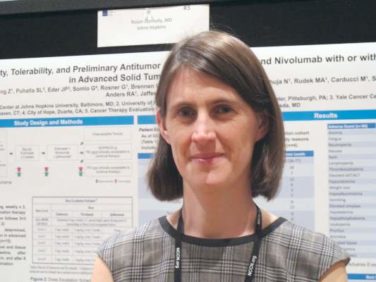EXPERT ANALYSIS FROM AACE 2016
ORLANDO (FRONTLINE MEDICAL NEWS) – Starting a patient with newly diagnosed type 2 diabetes mellitus on a single agent is a reasonable approach, but leaving them too long on monotherapy that proves ineffective is insupportable by available data, according to Dr. Richard Pratley.
“It’s not so much whether or not you start with a single drug or with two drugs, but it’s the fact that we don’t advance therapy when appropriate,” he said. Allowing hyperglycemia to persist increases health risks. “We can do better with a combination therapy initially, but we also do better just by advancing therapy sequentially better. Nobody has to spend 17 months with an A1c of eight and a half percent or so,” said Dr. Pratley, director of the Florida Hospital Diabetes Institute and an adjunct professor at the Sanford Burnham Medical Research Institute, both in Orlando.
It is reasonable on several grounds to start with a single agent, but “starting” is the operative word. No matter whether one initiates therapy with one drug or a combination, an essential component of any therapy is lifestyle modification, possibly including medically assisted weight loss, he noted during a point/counterpoint session at the annual meeting of the American Association of Clinical Endocrinologists (AACE).
Guidelines from both the American Diabetes Association and the European Association for the Study of Diabetes recommend starting with metformin and then moving on stepwise to add a second drug, then a third as needed, with each step separated by 3 months. If further therapy is needed, then insulin can be added after another 3-6 months. These organizations have taken the position that metformin “remains the optimal drug for monotherapy,” based on low cost, proven safety, weight neutrality, and possible cardiovascular benefits. However, if the hemoglobin A1c is 9% or greater, initial combination therapy with metformin plus another drug may achieve an HbA1c target more quickly than sequential therapy, he said.
In contrast to the ADA/EASD guidelines, the AACE recommends monotherapy with one of several agents only if the entry HbA1c is less than 7.5%, advancing to dual therapy after 1 month if still not at goal. If the entry HbA1c is at or above 7.5% but less than 9.0%, dual therapy including metformin is advised, moving to triple therapy after 1 month if the patient is still not at goal. Any patient with an entry HbA1c above 9% can start with dual or triple therapy if symptoms are absent, but if symptoms are present, insulin is recommended with or without other agents. “Combination therapy is usually required and should involve agents with complementary mechanisms of action,” according to an AACE consensus statement.
With an entry HbA1c between 7.5% and 9%, the decision to use monotherapy or a combination is a “gray area,” Dr. Pratley said. The arguments in favor of combination therapy are that a single agent may have limited efficacy, multiple metabolic abnormalities contribute to hyperglycemia, drugs with complementary mechanisms of action will work better, and getting to an HbA1c goal faster will improve outcomes. With twelve classes of antihyperglycemic agents, however, to treat type 2 diabetes mellitus (2DM), the combination possibilities are almost endless. Even excluding insulin, there are more than 150 possible recommended two-drug combinations.
Based on several studies, Dr. Pratley countered these arguments, saying that one agent is often enough to reach goal when the entry HbA1c is 7.5-9%. Furthermore, evidence is lacking that early control improves outcomes or the durability of response, and there is no comparative efficacy data on initial combination therapies. Initial combinations limit personalizing therapy because of diminished flexibility of dosing, and attribution of side effects to one agent or another may be blurred.
Since diabetes patients may have comorbidities, polypharmacy for 2DM may present more drug interactions and contribute to adverse effects, aside from the risk of severe hypoglycemia from the antidiabetic drugs themselves. Dr. Pratley said that a higher pill burden may decrease adherence, more drugs add to cost, and insurance companies may cover only stepped care.
Comparing drug prices, he said initial monotherapy with metformin for the 1.7 million newly diagnosed 2DM patients in the United States every year could save $1 billion vs. some combination therapies. He said he found metformin free at one supermarket chain pharmacy, while a bag of potting soil was nearly $5 at a store next door, making metformin “cheaper than dirt.”
Citing a retrospective, observational study of more than 7,200 complete courses of treatment for 2DM (Diabetes Care. 2004;27:1535-40), Dr. Pratley said patients had several years of excess glycemic burden before therapy was intensified, which he called “the real problem.” He noted that initial monotherapy works for patients with HbA1c less than 9.0%, with sequential personalized therapy to minimize side effects and cost. “Clinical inertia must be avoided,” he said, so the key to good initial monotherapy is not to delay adding drugs when necessary.
Session moderator Dr. Daniel Einhorn, medical director of the Scripps Whittier Diabetes Institute in La Jolla, Calif., commented in an interview that Dr. Pratley “made some very cogent arguments for minimizing the number of agents used and that the counter argument more recently for multiple-agent therapy has to be looked at in the context of what insurance companies will accept and the patients can tolerate.” He agreed that sequential therapy “is perfectly reasonable” as long as it is done rapidly, meaning waiting no longer than 3 months to add needed therapy. “If you go quickly in sequential therapy, it’s like the equivalent to starting combination from the beginning,” he said.
Dr. Pratley has received research support from Lexcon, Lilly, Merck, Novo Nordisk, sanofi, and Takeda and has been a consultant for AstraZeneca, Boehringer, GlaxoSmithKline, Lilly, Merck, Novo Nordisk, sanofi, and Takeda. All his honoraria are directed toward Florida Hospital, a nonprofit organization, and Dr. Pratley does not receive direct or indirect compensation for these services.






